Energy Concrete Structures, Eco Block Distributor
Email Jerry Cox 828-361-2757
We chose an ICF wall system because of the benefits they offer a solar heated home.
They provide very good insulation to keep the heat inside,
and a lot of thermal mass to even out the temperature fluctuations common to solar homes.
Another reason we chose this sytem is how easy it is to use.
I design homes, but I am not a builder. Jerry Cox was very easy to work with.
He sponsored a class that taught how to design and build an ICF wall system.
I have designed several other ICF homes for clients who want to use this system
The footers are ready to pour and we have assembled some of the ICF forms for the first course.
Because I got very busy with work, I hired a good friend of mine to build the window frames (bucks).
The purpose of the buck is to prevent the concrete from pouring into the window opening area
when the ICF walls are filled with concrete. The bucks also provide a way to attach the windows.
The company reccomends two types of bucks.
One is a very nice extruded vinyl system that fits perfectly to the ICF walls.
My limited budget would not allow for these. The other type is using pressure treated 2x12 boards.
I don't like the idea of pressure treated wood around every window and door.
Besides the issues some have with the chemicals that are used to treat the wood,
there is the possibility of moisture causing the wood to warp, opening up the home to air and water leaks.
Being a designer, I decided to come up with a cheaper and better solution.
For the actual buck material I found surplus vinyl decking at a construction salvage yard.
Even though it was old and sun faded, it was just what I needed.
The vinyl and cedar chip planks are 1-1/4"x 5-1/2".
Alone the material is not strong enough to withstand the force of wet concrete,
so I designed a system of reinforcement with 2x4 lumber and OSB panels cut into 12" strips.
1/2" anchor bolts are mounted into the vinyl to anchor it to the concrete wall.
The OSB and the lumber provide strong bracing around the edges of the window opening.
After the concrete is cured, the wood and OSB will be removed,
leaving behind the vinyl planks for window attachment.
We saved this lumber to be used elsewhere.
The advantages of this system are many.
It costs a lot less. The foam of the ICF wall insulation is much tighter to the window frames.
I used salvaged materials. The vinyl material will not warp or rot. It is very well anchored to the wall.
I can also take advantage of a much better way to install the windows using a clip mounted system.
If I ever have to remove the windows, I will be able to do this very easily from the inside of the home.
The windows will be recessed over two inches from the outside surface of the wall,
allowing for much better protection from the rain.
I can stucco around the window openings for a very clean attractive look.
My ICF supplier likes my window buck design.
Here is a buck sitting on a single ICF form, to illustrate how they work.
In the house, the buck will have ICF forms around the bottom, sides, and top,
with concrete poured between the white foam panels.
The 2x4 cross braces give the buck enough strength to hold back the wet concrete.
The round holes in the bottom of the buck are to pour concrete into the wall section below the window.
The boards and OSB will be stripped off when the concrete is cured.
All that will be left is the dark brown vinyl planks, anchored to the concrete with the anchor bolts.
The windows will be attached to the vinyl planks.
SEE OTHER ENTRIES IN OUR HOME DIARY BY
-Bonnie our helpful realtor can be contacted by EMAIL or by phoning her at 800-871-1910
Would you like to see this project under construction?
How to Contact The Mountain Home Show
Appreciation......
This web site contains information obtained from various sources.
The Mountain Home Show is not liable for the accuracy of this information.
Please contact the source of this information with your questions.

Pouring our first footers. We needed a concrete pump because the concrete truck could not get close enough to the cabin.

Brian Schmitz of Georgia Mountain Concrete is a friend of mine who is doing all of my concrete work.
He reccomended that we set our first course in the wet concrete for a much stronger stronger bond.
We ran a stringline for aligning the tops of the first course.
At first the concrete was so wet that the ICF blocks kept floating up.
But after a few minutes they stayed where they were set.
Now that the footers are dry, they are bonded very well to the ICF blocks.
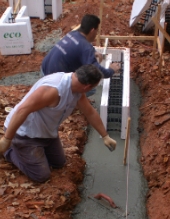
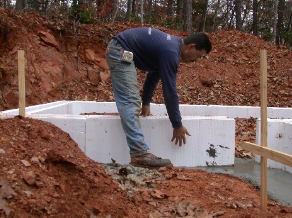
Here Brian is cutting one of the ICF forms to fit in a wall. These forms are very easy to cut.
Every inch there are lines marked on the form help you make straight cuts.
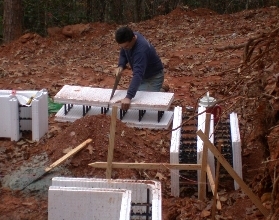
The next day a lot of good friends showed up to help us put up the walls.
They ran a little ahead of our planning and the walls ended up a little crooked.
Next we built the window frames (bucks) and rebuilt some of the walls.
An advantage of this system is that we can take it apart and rebuild it so quickly.
Each block is 48" long and 16" high, the size of six concrete blocks, but so much lighter!
We are using strong corner braces that we can adjust to make the walls straight and square.
Then we built the corners of the walls first, filling in the rest of the walls last.
This allowed us to build the walls accurately.
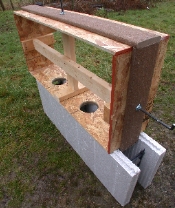
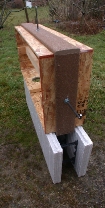
Here are some photos of these window frame bucks installed into the walls,
showing their reinforcement with 2x4 lumber across the inside,
and around the outside of each window.
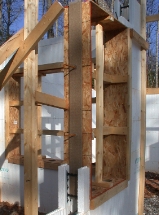
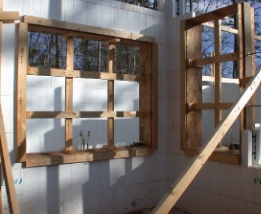
If you would like more information about this innovative ICF wall system,
see the top of the page to contact Jerry Cox.
CLICKING ON THE FOLLOWING LINKS:
(These will be updated throughout the project).
 Back to the Diary Home Page
Back to the Diary Home Page
 Step 1, Purchasing the Land
Step 1, Purchasing the Land
 Step 2, Designing Our Own Home
Step 2, Designing Our Own Home
 Step 3, Our Septic Permit
Step 3, Our Septic Permit
 Step 4, Our Insulated Wall System
Step 4, Our Insulated Wall System
 Step 5, Cutting Lumber from Our Own Trees
Step 5, Cutting Lumber from Our Own Trees
 Step 6, Plumbing Before the Slab is Poured
Step 6, Plumbing Before the Slab is Poured
 Step 7, Pouring the Concrete Floors
Step 7, Pouring the Concrete Floors
 Step 8, Pouring Concrete in the ICF Walls
Step 8, Pouring Concrete in the ICF Walls
 Step 9, Framing the Wood Walls, Floors, and Roof
Step 9, Framing the Wood Walls, Floors, and Roof
 Step 10, Installing the Windows
Step 10, Installing the Windows
 Step 11, Roughing in Plumbing and Electrical
Step 11, Roughing in Plumbing and Electrical
 Step 12, Insulation
Step 12, Insulation
 Step 13, Roofing Our Home
Step 13, Roofing Our Home
 Step 14, Finishing the Cabin
Step 14, Finishing the Cabin
I have friends in the construction industry who are very interested in this home.
In appreciation for their assistance, I would like to give them credit for their help,
and give you the opportunity to contact them.
The following list will be updated regularly:
-Tony of A&L Construction did the clearing, excavating, and sawed lumber from our trees. He can be reached at 828-835-9926.
-Pete is a very good part time carpenter. You can phone him at 828-479-9458.
Come to the next Mountain Home Show, and you will get an invitation to our open house.
For more informaiton, click on the link to "Detailed information about the home show."
If you are interested in building, you may also be able to make an appointment to visit.
Click on "Email Richard" to make an appointment.
Or perhaps you would like to observe the construction of this home on line.
Click on "Construction Diary."
You are welcome to visit often as we continually update it.
How to Contact Richard C. MacCrea
 My Facebook Page
My Facebook Page
(Design news and ideas)
Email Me
(Opens an email window)
800.738.8781 P.O. Box 446, Murphy, North Carolina 28906
Other Pages on this Web Site
 The Mountain Home Show, Home Page and Site Map
The Mountain Home Show, Home Page and Site Map
(How to find what you're looking for)
The Next Mountain Home Show Program
(For guests and exhibitors)
How to Get in The Mountain Home Show
(For exhibitors)
Articles
(About designing, building and remodeling a mountain home)
The Mountain Model Home
(A home that experiments with extreme energy efficiency)
The Mountain Model Cabin
(A cabin that experiments with small size and energy efficiency)
Construction Diary
(The joys and frustrations of building these two model homes)
Home Designing and Planning
(How to get plans for building or remodeling your home)
 Email Us
Email Us
(Opens an email window)
Like our Facebook Page
(Join our Mountain Home Show Community for news and contacts)
The Mountain Home Show, P.O. Box 446, Murphy, North Carolina 28906-0446
The Mountain Home Show owes its success to the businesses that participate in the show.
They arrange such wonderful exhibits.
It is obvious that they take great pride in their work and our show.